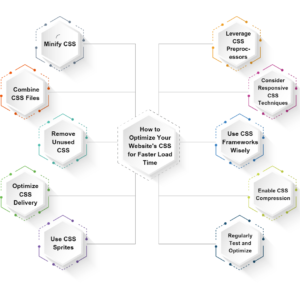When it comes to optimizing your website for faster load time, CSS (Cascading Style Sheets) plays a crucial role. Bloated or poorly optimized CSS files can significantly impact your website’s performance, leading to slower load times and a less satisfying user experience. In this blog, we will explore effective strategies to optimize your website’s CSS for faster load time, ensuring a seamless and engaging browsing experience.

Minify CSS:
Minifying CSS involves removing unnecessary characters such as whitespace, comments, and redundant code. This reduces the file size of your CSS, allowing it to load faster. Use online tools or build processes to automatically minify your CSS files while preserving their functionality.
Combine CSS Files:
If your website uses multiple CSS files, consider combining them into a single file. Each CSS file requires a separate HTTP request, which can slow down load times. Combining CSS files reduces the number of requests, resulting in faster loading. However, be cautious not to merge files that are loaded conditionally or on specific pages to maintain the necessary modularity.
Remove Unused CSS:
Analyze your CSS files to identify and remove any unused or redundant code. Over time, CSS files can accumulate unused styles due to design changes or modifications. Removing these unused styles reduces the file size and allows the browser to load and render your CSS more efficiently.
Optimize CSS Delivery:
Optimizing CSS delivery involves loading critical CSS first to render the initial content quickly. Inline critical CSS or use server-side rendering techniques to ensure that the essential styles are available immediately. Load non-critical CSS asynchronously or defer its loading until after the initial content is visible to improve load times.
Use CSS Sprites:
CSS sprites combine multiple images into a single image file, reducing the number of HTTP requests required to load them. By utilizing CSS sprites, you can minimize the file size and improve load times, as the browser only needs to download one image instead of multiple individual ones.
Leverage CSS Preprocessors:
CSS preprocessors like Sass or Less provide powerful features that can optimize your CSS. These preprocessors offer functions, mixins, variables, and more, allowing you to write cleaner and more efficient code. Additionally, preprocessors automatically handle minification and concatenation, simplifying your optimization workflow.
Consider Responsive CSS Techniques:
If your website is responsive, optimize your CSS for different screen sizes by utilizing responsive design techniques like media queries. By tailoring the styles to specific screen sizes, you can prevent unnecessary CSS from being loaded on devices where it’s not required, improving load times for mobile users.
Use CSS Frameworks Wisely:
CSS frameworks like Bootstrap or Foundation provide pre-built styles and components, but they can also result in bloated CSS files. When using a CSS framework, ensure that you only include the necessary components and styles. Remove any unused styles or override them to reduce the file size and optimize load times.
Enable CSS Compression:
Enable server-side compression, such as GZIP, for CSS files. Compressing your CSS files reduces their file size during transmission, allowing them to be downloaded faster by the user’s browser. Configure your server to apply compression to CSS files, ensuring optimal load times.
Regularly Test and Optimize:
Regularly monitor your website’s performance using tools like Google PageSpeed Insights or GTmetrix. These tools provide insights into your CSS performance, highlighting areas for further optimization. Continuously test and fine-tune your CSS to ensure it remains optimized and delivers fast load times.
In Short, Optimizing your website’s CSS is essential for achieving faster load times and providing a seamless user experience. By minifying CSS, combining files, removing unused styles, optimizing CSS delivery, using CSS sprites, leveraging preprocessors, employing responsive techniques, using CSS frameworks wisely, enabling compression, and regularly testing, you can significantly improve your website’s performance. Implement these strategies and enjoy a faster, more responsive website that keeps visitors engaged and satisfied.
Check out our Previous Blogs- Keep Up With All The Latest In The Digital World


